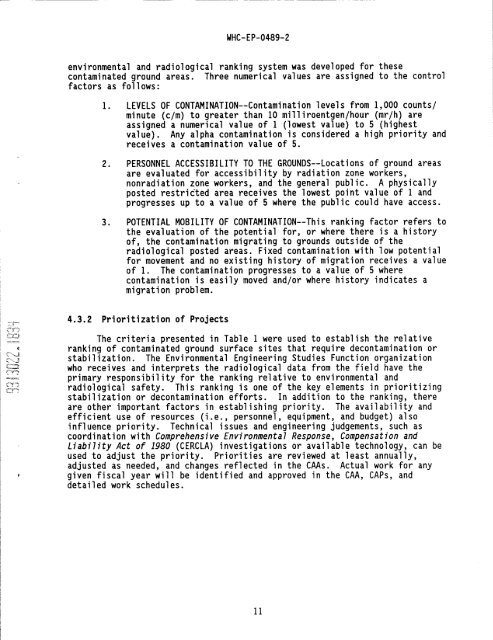IS PAGEli - Hanford Site
IS PAGEli - Hanford Site
IS PAGEli - Hanford Site
Create successful ePaper yourself
Turn your PDF publications into a flip-book with our unique Google optimized e-Paper software.
WHC- EP-0489-2<br />
environmental and radiological ranking system was developed for these<br />
contaminated ground areas. Three numerical values are assigned to the control<br />
factors as follows:<br />
1. LEVELS OF CONTAMINATION--Contamination levels from 1,000 counts/<br />
minute (c/in) to greater than 10 milliroentgen/hour (mr/h) are<br />
assigned a numerical value of 1 (lowest value) to 5 (highest<br />
value). Any alpha contamination is considered a high priority and<br />
receives a contamination value of 5.<br />
2. PERSONNEL ACCESSIBILITY TO THE GROUNDS--Locations of ground areas<br />
are evaluated for accessibility by radiation zone workers,<br />
nonradiation zone workers, and the general public. A physically<br />
posted restricted area receives the lowest point value of 1 and<br />
progresses up to a value of 5 where the public could have access.<br />
3. POTENTIAL MOBILITY OF CONTAMINATION--This ranking factor refers to<br />
the evaluation of the potential for, or where there is a history<br />
of, the contamination migrating to grounds outside of the<br />
radiological posted areas. Fixed contamination with low potential<br />
for movement and no existing history of migration receives a value<br />
of 1. The contamination progresses to a value of 5 where<br />
contamination is easily moved and/or where history indicates a<br />
migration problem.<br />
4.3.2 Prioritization of Projects<br />
The criteria presented in Table 1 were used to establish the relative<br />
ranking of contaminated ground surface sites that require decontamination or<br />
stabilization. The Environmental Engineering Studies Function organization<br />
who receives and interprets the radiological data from the field have the<br />
primary responsibility for the ranking relative to environmental and<br />
radiological safety. This ranking is one of the key elements in prioritizing<br />
stabilization or decontamination efforts. In addition to the ranking, there<br />
are other important factors in establishing priority. The availability and<br />
efficient use of resources (i.e., personnel, equipment, and budget) also<br />
influence priority. Technical issues and engineering judgements, such as<br />
coordination with Comprehensive Environmental Response, Compensation and<br />
Liability Act of 1980 (CERCLA) investigations or available technology, can be<br />
used to adjust the priority. Priorities are reviewed at least annually,<br />
adjusted as needed, and changes reflected in the CAAs. Actual work for any<br />
given fiscal year will be identified and approved in the CAA, CAPs, and<br />
detailed work schedules.

















